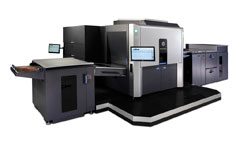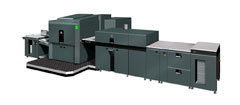On Print | Electrophotography for Packaging
- Published: August 07, 2012, By Dene H. Taylor
In spite of all the digital printing activity at drupa 2012, there are surprisingly few options immediately available for the packaging industry. The bulk of these are for electrographic (EPG) printers, i.e., machines using toner, and they were all in action.
Roll-to-roll EPG presses are much better known for label printing. Labelexpo will be with us shortly, so look to PFFC for news and coverage about this market segment. That leaves just folding carton and flexible packaging. Fortunately, the primary OEMs all displayed their next-generation presses, which of course are wider, faster, and more capable with, for example, longer sheet sizes, more toner choices, and even in-line color measurement and control.
Software does not interest me much, but I like the continuing trend for the OEMs to supply complete production software suites. It is obviously beneficial to have the best of third party components, like EFI’s Fiery, integrated with the press operating systems, etc.
HP Indigo, the main player for  packaging, introduced three 29.5-in.-wide EPG presses: Indigo 10000 for sheets and the Indigo 20000 and 30000 for webs. Other than the greater width, they offer essentially the same performance as the ubiquitous 14-in. machines. We know them for excellent image quality on a broad spectrum of substrates going into a wide number of demanding uses. And they have respectable productivity.
packaging, introduced three 29.5-in.-wide EPG presses: Indigo 10000 for sheets and the Indigo 20000 and 30000 for webs. Other than the greater width, they offer essentially the same performance as the ubiquitous 14-in. machines. We know them for excellent image quality on a broad spectrum of substrates going into a wide number of demanding uses. And they have respectable productivity.
 A four-color Indigo 10000 can run to 3,450 sheet/hr (1500 m2/hr for 29.5 x 20.9 in. stock). With a thickness limit of 18 pt, it can be used for folding carton, although it is primarily intended for commercial printing with release early next year.
A four-color Indigo 10000 can run to 3,450 sheet/hr (1500 m2/hr for 29.5 x 20.9 in. stock). With a thickness limit of 18 pt, it can be used for folding carton, although it is primarily intended for commercial printing with release early next year.
Indigo’s 30000, however, has been designed specifically for folding carton production with substrate to 24 pt. Corona treater and primer station will be standard, and being sheet fed, it will easily integrate with automated finishing equipment.
 The first 10000 installation is later this year in China with a company that includes folding carton in its business. The 30000 is scheduled for release in 2014.
The first 10000 installation is later this year in China with a company that includes folding carton in its business. The 30000 is scheduled for release in 2014.
All Indigos need pre-treated substrates, but in-line primer stations are now standard options. CMYK is the basic four-color set, while six and seven ink stations are available on some models to extend the color gamut or to enable spot colors, the latter using HP’s IndiChrome ink mixing system, or white. The new members of the Indigo 7000 series also may be purchased with an embossed-style texture, which is a further feature for folding carton printing.
HP has established a niche with flexible film packaging, as the Indigo is the only EPG device that does not rely on hot fusing. Its web machines, such as the 13-in. model 7250, can process films as thin as 48 ga PET and 40 ga OPP, which gives it access to a good deal of the flexible packaging market. For example, pouches use these films laminated print-side-in to PE. But there are limitations for food packaging because of a few ingredients in the toner. Pouches for a wide range of dry food and cartons for many retail items were shown in the Indigo Supermarket. Obviously there is homework in this area for anyone contemplating this market segment.
We do not see a competitor to the Indigo for flexible film packaging in the near future. Indeed, it is likely to be Landa Digital Printing that offers the first alternative when the presses using its technology are being placed at the end of 2013. But by then, HP should be placing its 29-in. wide Indigo 20000 for film printing. It is designed with flexible packaging in mind and will be building on the experiences of the WS 4600 and the WS 6600, also introduced at drupa. At about 100 fpm for four-color printing, it will increase the useful run size as well as open the door to items with a bigger footprint, especially for pouch and bag production. Indeed, some of our own clients will at last be enabled. And substrate selection is extended as it too comes with corona and in-line primer station.
Xeikon’s two decades of web printing experience shows with the steady performance of its 3500 20-in.-wide press running at 63 fpm for paper, while slower with paperboards. It has position with folding carton for food products, although for our interests the Xeikon presses are much better known for labels. And Xeikon offers a range of models that can be field upgraded for speed and width, so that anyone new to the business can limit initial capital outlay while building sales. Dry toner requires direct heat to fuse the powder to the substrate. As the temperature is above the softening point of film plastics, those popular for flexible packaging are not able to be processed (unless on a carrier). But that is not stopping developments with transfer printing.
Trillium, a new high productivity liquid toner press, got the most attention at Xeikon’s booth. Liquid toner was chosen over inkjet to ensure offset-like image quality for commercial printing. This wide machine has an offset press-like structure with separate color stations. It was demonstrated at about 200 fpm, although capable of double that. It will be released in about two years, but not for the packaging market – the method for removing residual toner carrier fluid does not appear compatible with thin film. Xeikon has taken a major position with liquid toner technology by acquiring the rights to at least eight patents from Research Laboratories of Australia (RLA). (Most EPG patents are dry reading, but these are quite engaging.)
Although not shown at drupa, Canon-Oce announced the InfiniStream, another wide web (28-in.) liquid toner printer. It too is assembled like an offset press with separate print stations and, while capable of handling paperboard, is primarily targeted for commercial print.
Miyakoshi’s Digital Press 8000 has the highest productivity of the large sheet presses being rated at 8000 sheets/hr (3780 m2/hr for 31 x 24-in. paper). It is the second iteration of Miyakoshi’s 1200 dpi liquid toner process – the Digital Press 5000 was shown at drupa 2008 – which also has its roots at RLA. Ryobi contributed the offset-style frame and paper handling, so the 8000 has a straight paper path and separate print stations for each color. The primary market is commercial print, but it can handle 16-pt paperboard and therefore support folding carton production after it is released.
There was one other B-sized sheet press using toner – the QPress from Jadason Technologies Ltd., a Hong Kong company with technology from Japan and manufacturing in China. The web path is straight. The image is formed on a belt circulating past the separate color stations in a tower. It can print on paper and paperboard from 40–160 lb at about 18 full size sheets/min. Jadason has placed about 20 presses in Asia. Drupa was the initiation of a sales effort for Europe. Previously, I was under the impression dry toner technology was not amenable to printing wider than about 14 in., but this machine is 20 in. It has been around longer than Xeikon’s 20-in.-wide presses, the DCP 500 and 3500 for example, so I hope there is wider activity behind the closed doors of other OEMs and that we see before the next drupa.
Xerox continued to display its commitment to the folding carton industry. Its partnership with Stora-Enso to supply integrated systems capable of producing printed, die-cut, creased, and varnished flats has been successful. Stora-Enso’s Gallop was shown to be an efficient folding carton finishing system. It was converting sheets up to 600 x 364 mm, and about 250 gsm, coming directly from an iGen4 EXP at up to 2400 sheets/hr. Prior to the die-cutting and creasing is a coating station that can run either aqueous or UV-cure. Aqueous coatings are, of course, often specified by the pharmaceutical industry. The coater is flexo-style, which minimizes coating pattern. The anilox roll sleeve-type so it is easy to care for and change, which is a step forward from some of the small coaters of not that long ago. Attractive small cartons for retail applications were being produced at the show by the combination. Close by we saw Xerox’s newest and fastest printer in this family, the iGen 150, capable of one-side printing at 3,000 sheets/hr. And it has another capability we are seeing more of in digital printers – in-line color measurement and control.
 Kodak has more features for the NEXPRESS that add to its appeal for folding carton packaging. The Fifth Imaging Unit Solution enables spot colors, gold, and pearlescent effects. I always feel that metallic and pearlescent touches give a graphics a distinguished look and packaging a rich feel. The additional station also allows in-line dimensional printing, high quality gloss, in-line watermarking, or coating in a single pass, which are further value-adding image features for premium applications. At drupa these were all demonstrated on postcards, so the utility for packaging was obvious. The NEXPRESS SX3900 is rated at more than 3,200 14 x 20.5-in. sheets/hr. And like all sheet printers, it can be readily integrated with subsequent processes. The NexPress line has been designed so that the base model can be upgraded progressively for speed and capability.
Kodak has more features for the NEXPRESS that add to its appeal for folding carton packaging. The Fifth Imaging Unit Solution enables spot colors, gold, and pearlescent effects. I always feel that metallic and pearlescent touches give a graphics a distinguished look and packaging a rich feel. The additional station also allows in-line dimensional printing, high quality gloss, in-line watermarking, or coating in a single pass, which are further value-adding image features for premium applications. At drupa these were all demonstrated on postcards, so the utility for packaging was obvious. The NEXPRESS SX3900 is rated at more than 3,200 14 x 20.5-in. sheets/hr. And like all sheet printers, it can be readily integrated with subsequent processes. The NexPress line has been designed so that the base model can be upgraded progressively for speed and capability.
Other companies with nominal 13 x 20-in. presses able to handle paperboard include Konica Minolta (e.g., bizhub Press C8000), Ricoh (e.g., ProC901S) and MGI (Meteor product line). MGI has successfully marketed the capability of the Meteor to print on relatively rigid 4–16 mil plastic substrates such PVC, PET, and PC. It also can directly feed finishing equipment, including the MGI JetVarnish, which has pattern, tactile, or full-coverage inkjet coating capability.
Printing expert Dene Taylor, PhD, founded Specialty Papers & Films Inc. (SPF-Inc.), New Hope, PA, in 2000 for clients seeking consultation for technical management, new product design, development, commercialization, and distribution, as well as locating/managing outsourced manufacturing. Contact him at 215-862-9434; This email address is being protected from spambots. You need JavaScript enabled to view it.; www.spf-inc.com.




